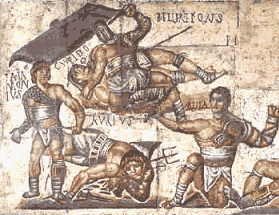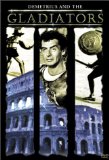
books
music
film & videos
gifts
travel
food & wine
genealogy
italian american
features
news
forums
free email
newsletter
link directory
|
new york
events, links, forum
boston
events, links, forum
new!philadelphia
events, links, forum
chicago
events, links, forum
san francisco
events, links, forum
los angeles
events, links, forum
|
|
about us
|
you can help us!
We're an all volunteer website and need your help to keep going. Here are five ways you can contribute:
1 Donate
2 Buy something
3 Submit a story
4 Volunteer
5 Advertise

get in gear!
New in the gift shop, virtualitalia.com logo wear and use items!

|
|
PLEASE NOTE: We are experiencing unexpected
technical difficulties caused by our web host. We apologize for
the inconvenience. During your visit you may experience service
and page interruptions - we are in the process of fixing everything and hope to be
fully back on our feet soon.
gladiators
italian blood sport of the roman empire
By Laura Pazzaglia
 The release of a recent film, The Gladiator, has revived interest and intrigue of a Roman duel to the death born from a ritual and raised to entertainment. Here s a peek a the life of a Gladiator, 5 can't-miss Gladiator flicks and related websites that describe this "sport" in greater detail.
The release of a recent film, The Gladiator, has revived interest and intrigue of a Roman duel to the death born from a ritual and raised to entertainment. Here s a peek a the life of a Gladiator, 5 can't-miss Gladiator flicks and related websites that describe this "sport" in greater detail.
The Life of a Gladiator
A Gladiator was a trained warrior who fought bloody battles to entertain the ancient Romans. They were generally condemned criminals, prisoners of war or slaves bought for this purpose. Some free men entered this profession in hopes of popularity and patronage by wealthy citizens. Knights, senators, dwarfs and even women occasionally fought. One emperor, Commodus, also fought in the arena. The free men were often social outcasts, freed slaves or discharged soldiers. They volunteered to be gladiators and by the end of the Republic made up half the number of combatants.
Successful gladiators became famous in Rome. The comment "the girls' delight" is scratched after the name of one gladiator on a Pompeian wall. One of the most famous gladiators was Spartacus, a slave from Thrace who led an unsuccessful rebellion of gladiators and slaves. Gladiators were carefully fed, and they received medical care. They were generally housed in barracks.
Gladiators were trained in combat at special, imperial schools and used many different types of weapons. Some of the warriors used an oblong shield, a visored helmet, and a stabbing sword about 2 feet long. Some used a small, round shield called a buckler and a sica (short, curved sword). Others used only a net and a three-pronged spear called a trident. Gladiators usually fought until one was killed. However, the life of the loser could be spared if the spectators waved handkerchiefs or displayed a "thumbs-up" signal (there are scholarly debates about what method was actually used for this purpose).
The first gladiators were part of a sacrificial rite adopted from the Etruscans. First introduced to Rome in 264 BC, the sons of Junius Brutus honored their father at his funeral by matching three pairs of gladiators.
|
...wild beasts fought in the morning, gladiators fought in the afternoon.
|
Gladiatorial combat was originally part of a religious ceremony that was intended to insure that the dead would be accompanied to the "next world" by armed attendants and that the spirits of the dead would be appeased with this offering of blood.
Most gladiator matches that were held at funerals or celebrations, and were under state control. At the Colosseum, wild beasts fought in the morning, and the gladiators fought in the afternoon. Contests were also held in provincial amphitheaters. Many Greek theaters were converted to house the popular fights. These cruel battles were justified as hardening Roman citizens to the sight of human bloodshed, so they could endure war better. The battles were finally banned about A.D. 404 by Emperor Honorius.
Unfortunately, the popularity of these spectacles led to the death of tens of thousands of animals. Entire species were no longer found in their native habitat, and some were even driven to extinction.
Thanks to the magic of Hollywood, you can take a peek back in time with...
Can't Miss Gladiator Flicks
Colosseum - A Gladiator's Story (2003)
Travel back in time to the glamour and bloodshed of ancient Rome's gladiatorial world, where men fought for their lives to satisfy the whims of emperors and a bloodthirsty populace. Combining compelling narrative with state-of-the-art computer graphics and high-quality drama reconstruction, this production throws new light on the way gladiators really fought and trained, and reveals that many of them were the superstars of their age. Colosseum: A Gladiator's Story revolves around the true story of Verus, who rises from slave to star gladiator, but who faces the ultimate challenge in one of the very few gladiatorial fights that was recorded and described by contemporary writers. Discover Verus' story, live his journey and experience his quest for freedom.
Gladiator (2000)
Maximus is a powerful Roman general, loved by the people and the aging Emperor, Marcus Aurelius. Before his death, the Emperor chooses Maximus to be his heir over his own son, Commodus, and a power struggle leaves Maximus and his family condemned to death. The powerful general is unable to save his family, and his loss of will allows him to get captured and put into the Gladiator games until he dies. The only desire that fuels him now is the chance to rise to the top so that he will be able to look into the eyes of the man who will feel his revenge.
The Fall of the Roman Empire (1964), starring Sophia Loren
The Roman general Livius follows the precepts of Marcus Aurelius, in hopes of creating an empire at peace within and without its borders. The accession of the unstable Commodus puts this goal in jeopardy. The Gladiator (detailed above) was a remake of this movie with slightly more attention to historical details and, with the exception of Sophia Loren's apperance in this film, slightly better dialouge.
Spartacus (1960), starring Kirk Douglas
The rebellious Thracian Spartacus, born and raised a slave, is sold to Gladiator trainer Batiatus. After weeks of being trained to kill for the arena, Spartacus turns on his owners and leads the other slaves in rebellion. As the rebels move from town to town, their numbers swell as escaped slaves join their ranks. Under the leadership of Spartacus, they make their way to southern Italy, where they will cross the sea and return to their homes. Meanwhile, in Rome, the slave revolt has become a deciding factor in the power struggle between two senators: the republican Gracchus and the militarist Crassus, each of whom sees the fortunes of the rebellion as the key to his own rise to power or humiliating defeat. As the two statesmen attempt to aid, hinder and manipulate the rebels for their own benefit, Spartacus and his followers press on toward freedom.
Demetrius and the Gladiators (1954)
Great-looking bad actor Victor Mature stars in this action-packed 1954 sequel to the more religious, better-behaved The Robe. Heavy on sadomasochism and big on mysticism, this CinemaScope spectacular highlights the genre's three R's--Rape, Revenge and Resurrection--as well as extreme examples of such overacted staples as the horny empress (Susan Hayward's Messalina) and the hysterical emperor (Jay Robinson's Caligula). Christ's robe is given to Peter for safe-keeping, but the emperor Caligula wants it back to benefit from its powers. Marcellus' former slave Demetrius seeks to prevent this, and catches the eye of Messalina, wife to Caligula's uncle Claudius. Messalina tempts Demetrius, he winds up fighting in the arena, and wavers in his faith.
The Sign of the Cross (1932)
Cecil B. DeMille's 1932 epic set the pattern for most Roman spectacles that followed: A powerful pagan falls for a virginal Christian, tries to save her and ends up joining her on the lion's menu.
After burning Rome, Emperor Nero decides to blame the Christians, and issues the edict that they are all to be caught and sent to the arena. Two old Christians are caught, and about to be hauled off, when Marcus, the highest military official in Rome, comes upon them. When he sees their stepdaughter Mercia, he instantly falls in love with her and frees them. Marcus pursues Mercia, which gets him into trouble with Emperor (for being easy on Christians) and with the Empress, who loves him and is jealous.
This film, was made before the censorious production code was enforced, so DeMille got to mix his patented piety with plenty of near-nudity (Claudette Colbert's ass-milk bath is still one of the hottest skinny-dipping scenes ever filmed), rampant homoeroticism (Charles Laughton's Nero slobbers buckets over Frederic March's aptly named Marcus Superbus) and outrageous arena matchups (when the fight card finally comes down to Barbarian Women versus African Pygmies, the movie reaches a kind of politically incorrect nirvana).
Gladiator Sites:
|



 The release of a recent film, The Gladiator, has revived interest and intrigue of a Roman duel to the death born from a ritual and raised to entertainment. Here s a peek a the life of a Gladiator, 5 can't-miss Gladiator flicks and related websites that describe this "sport" in greater detail.
The release of a recent film, The Gladiator, has revived interest and intrigue of a Roman duel to the death born from a ritual and raised to entertainment. Here s a peek a the life of a Gladiator, 5 can't-miss Gladiator flicks and related websites that describe this "sport" in greater detail.



